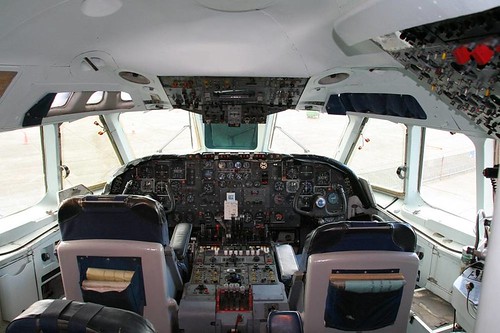
Record shot - old airliner cockpit
The way a photograph is taken differs according to the purpose of the shot. In this post I define what is meant by a record shot…
Definition: Record Shot(s); Record series;
![]()
Record Shot
A record shot is where the emphasis is on creating a record of the photographed object. you are not trying to portray the object in an artistic representation.
A record shot for your own use
Take a shot of a bird in your garden. In its simplest form it just captures the bird as it is seen. However, professional photographers and competition judges what to see some interpretation of what that bird is like in nature. So the more interesting shots will show it eating, or fighting, or showing some natural behavior that is not just “being a bird on a stick”. Likewise, other wildlife are always more interesting when they are, so to speak, in action. These ‘in action’ shots are NOT what we would call a record shot. The record shot is the straight forward representation of the detail of the object, animal or whatever you are recording. It brings out the essential essence of the look and feel of the subject. It does not include behavioral or interpretive art.
Reasons for taking a record shot
A record shot may simply be a shot you take to remember you have been somewhere. It may show you have done something. Your shots as records could be, for example, a complete insurance inventory for your house. Then again, it could be the birds you are following in your garden. As you can see, there are a whole range of things you might want to take such shots for at home.
The record shot is important to the professional
Record shots are increasingly used in a professional context. It’s normal for such shots to be retained for future reference (archived). They often form a history of the condition of an object.
Record shots are frequently used to record items for valuation, especially for insurance or recovery purposes. They may also form part of the ‘provenance’ of an artwork – proof of its origin, history, condition and ownership. They are often used to record work-flow, project progress or to validate contract completion. The latter may include a record of progress for legal reasons.
Increasingly, the staff headshot is used for the records of the organisation. They may be used in the front office operations. Head shots inform the public who the staff are and their names. But the headshot is also used in the back office for personnel reasons and staff record-keeping. These shots have now become part of the rich lexicon of legal and professional management of the company.
Record sequences and time considerations
Multiple shots are often taken for record purposes. This creates a complete record from all aspects of the item for a given time. Normally, the shots follow logical and straight-forward points of view. Thus, a record of a car might be taken one from all sides and above; one of the engine, boot (trunk) and interior shots.
A Record shot, or record series, are often taken periodically. This creates a complete set of time-period shots. This historical record sequence is used to determine changes, deterioration and updates – including repairs.
Record shot expertise
Record shots require their own expertise. Record shot photography provides a complementary background for other materials. Documents, reports and scientific work all require documentary images forming a record for the work. Artifacts and historical pieces are photographed for cataloguing, publication, preservation, valuation and repair.
Considerations when taking a record shot
Taking a record shot is not always straight forward. The photographer needs to provide a complete record of the item. All angles and aspects of the item need to be considered in a complete series. Also, one must be careful to ensure the photography does not damage it (e.g. camera flash can damage manuscripts and paintings). Consider that some items need careful handling, mounting or arranging. This is especially the case where historical artifacts need to be recorded for preservation purposes.
In insurance, engineering, science and medical records very specific or precise angles and perspectives are required. Record photographers often follow pre-set procedures to ensure representative comparable images. There is also a detailed set of metadata records required to go with this type of work. It will ensure the proper cataloguing and filing of the images.
Record shots are frequently the recording method in forensic and investigative science. Such shots are often used in court proceedings. High photographic standards are essential. forensic proof is a very precise science. The work must also include professional record keeping of the forensic photographic process itself.
The background in a record shot
It is simply impossible to separate out the detail in some pieces when there is a complex or difficult background. When taking a record shot you should be careful to pay attention to the background. Make it simple, appropriate, devoid of unnecessary detail. If possible provide a blank background, proper lighting and ensure effective use of contrast to separate the piece from the background. These are essential to make sure the proper details are preserved in your subject item.
Record shots are used by a wide range of professional services including medicine
Time and Photographs Stand Still For No Man
Shedding Light on Your Life and Times
Time

